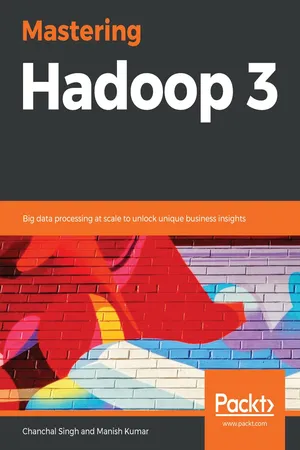
Mastering Hadoop 3
Big data processing at scale to unlock unique business insights
- 544 pages
- English
- ePUB (mobile friendly)
- Available on iOS & Android
Mastering Hadoop 3
Big data processing at scale to unlock unique business insights
About this book
A comprehensive guide to mastering the most advanced Hadoop 3 concepts
Key Features
- Get to grips with the newly introduced features and capabilities of Hadoop 3
- Crunch and process data using MapReduce, YARN, and a host of tools within the Hadoop ecosystem
- Sharpen your Hadoop skills with real-world case studies and code
Book Description
Apache Hadoop is one of the most popular big data solutions for distributed storage and for processing large chunks of data. With Hadoop 3, Apache promises to provide a high-performance, more fault-tolerant, and highly efficient big data processing platform, with a focus on improved scalability and increased efficiency.
With this guide, you'll understand advanced concepts of the Hadoop ecosystem tool. You'll learn how Hadoop works internally, study advanced concepts of different ecosystem tools, discover solutions to real-world use cases, and understand how to secure your cluster. It will then walk you through HDFS, YARN, MapReduce, and Hadoop 3 concepts. You'll be able to address common challenges like using Kafka efficiently, designing low latency, reliable message delivery Kafka systems, and handling high data volumes. As you advance, you'll discover how to address major challenges when building an enterprise-grade messaging system, and how to use different stream processing systems along with Kafka to fulfil your enterprise goals.
By the end of this book, you'll have a complete understanding of how components in the Hadoop ecosystem are effectively integrated to implement a fast and reliable data pipeline, and you'll be equipped to tackle a range of real-world problems in data pipelines.
What you will learn
- Gain an in-depth understanding of distributed computing using Hadoop 3
- Develop enterprise-grade applications using Apache Spark, Flink, and more
- Build scalable and high-performance Hadoop data pipelines with security, monitoring, and data governance
- Explore batch data processing patterns and how to model data in Hadoop
- Master best practices for enterprises using, or planning to use, Hadoop 3 as a data platform
- Understand security aspects of Hadoop, including authorization and authentication
Who this book is for
If you want to become a big data professional by mastering the advanced concepts of Hadoop, this book is for you. You'll also find this book useful if you're a Hadoop professional looking to strengthen your knowledge of the Hadoop ecosystem. Fundamental knowledge of the Java programming language and basics of Hadoop is necessary to get started with this book.
Frequently asked questions
- Essential is ideal for learners and professionals who enjoy exploring a wide range of subjects. Access the Essential Library with 800,000+ trusted titles and best-sellers across business, personal growth, and the humanities. Includes unlimited reading time and Standard Read Aloud voice.
- Complete: Perfect for advanced learners and researchers needing full, unrestricted access. Unlock 1.4M+ books across hundreds of subjects, including academic and specialized titles. The Complete Plan also includes advanced features like Premium Read Aloud and Research Assistant.
Please note we cannot support devices running on iOS 13 and Android 7 or earlier. Learn more about using the app.
Information
Section 1: Introduction to Hadoop 3
-
Chapter 1, Journey to Hadoop 3
-
Chapter 2, Deep Dive into the Hadoop Distributed File System
-
Chapter 3, YARN Resource Management in Hadoop
-
Chapter 4, Internals of MapReduce
Journey to Hadoop 3
- Hadoop origins
- Hadoop Timelines
- Hadoop logical view
- Moving towards Hadoop 3
- Hadoop distributions
Hadoop origins and Timelines
Origins
- Fault tolerant: The system should be able to handle any failure of the machines automatically, in an isolated manner. This means the failure of one machine should not affect the entire application.
- Load balancing: If one machine fails, then its work should be distributed automatically to the working machines in a fair manner.
- Data loss: They also wanted to make sure that, once data is written to disk, it should never be lost even if one or two machines fail.
MapReduce origin
Timelines
| Year | Event |
| 2003 |
|
| 2004 |
|
| 2006 |
|
| 2007 |
|
| 2008 |
|
Table of contents
- Title Page
- Copyright and Credits
- Dedication
- About Packt
- Foreword
- Contributors
- Preface
- Section 1: Introduction to Hadoop 3
- Journey to Hadoop 3
- Deep Dive into the Hadoop Distributed File System
- YARN Resource Management in Hadoop
- Internals of MapReduce
- Section 2: Hadoop Ecosystem
- SQL on Hadoop
- Real-Time Processing Engines
- Widely Used Hadoop Ecosystem Components
- Section 3: Hadoop in the Real World
- Designing Applications in Hadoop
- Real-Time Stream Processing in Hadoop
- Machine Learning in Hadoop
- Hadoop in the Cloud
- Hadoop Cluster Profiling
- Section 4: Securing Hadoop
- Who Can Do What in Hadoop
- Network and Data Security
- Monitoring Hadoop
- Other Books You May Enjoy